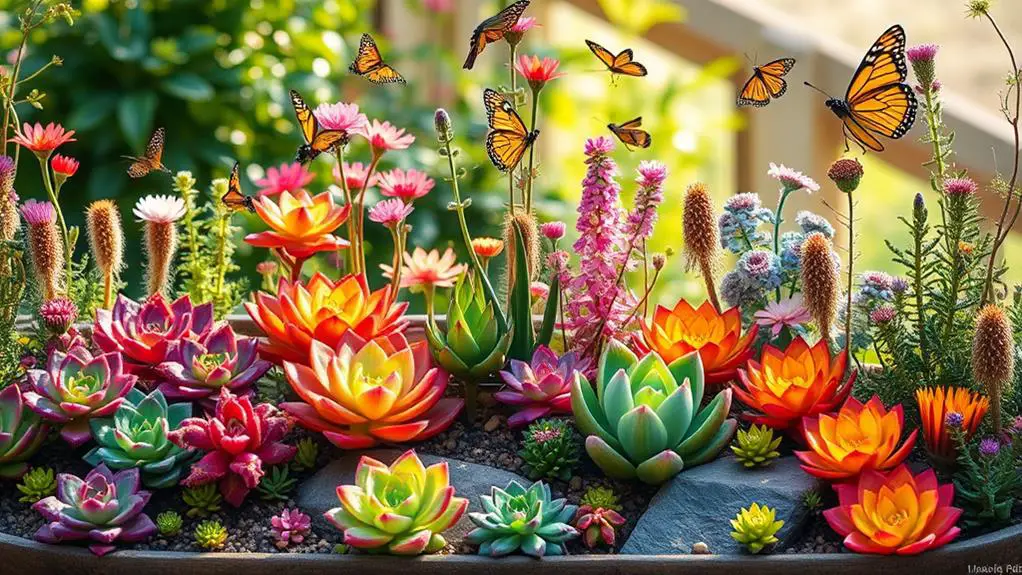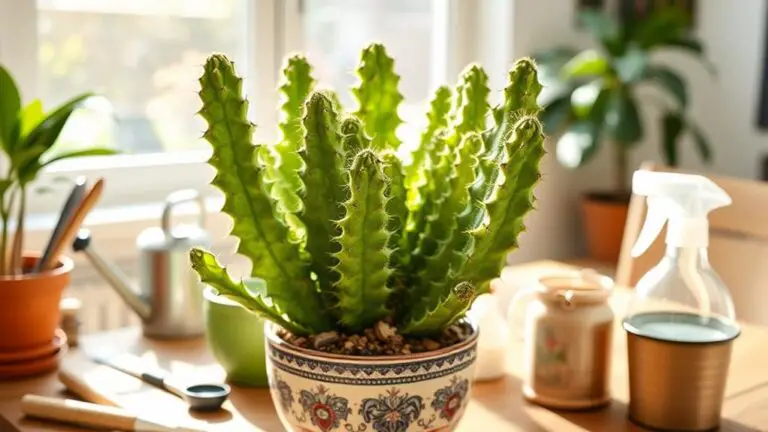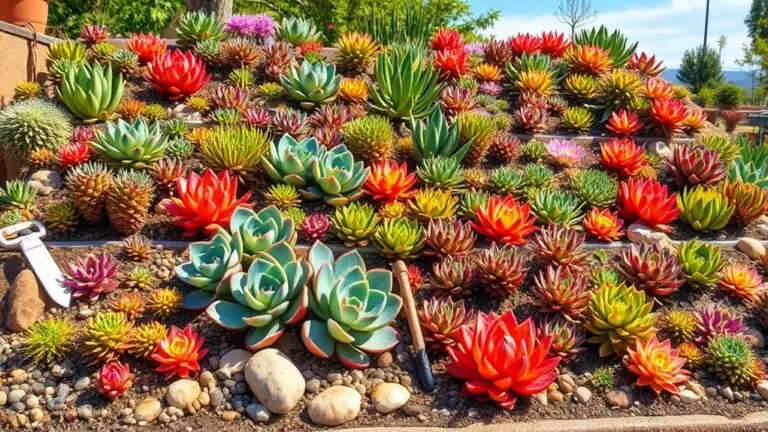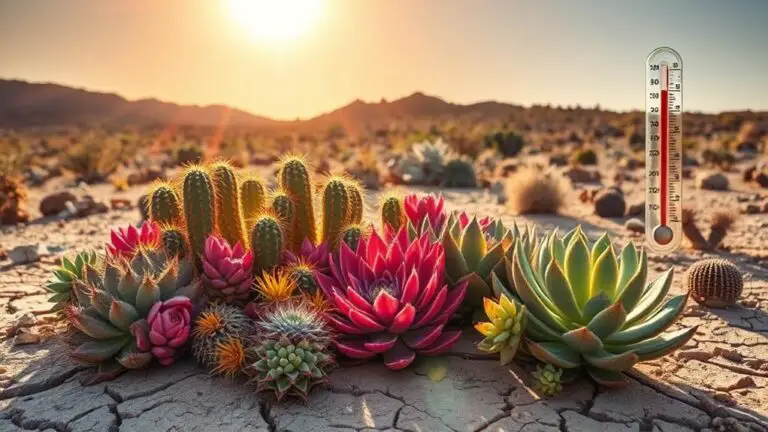7 Tips for Creating a Small Succulent Garden That Attracts Birds & Butterflies
Creating a small succulent garden that draws in birds and butterflies can be a rewarding endeavor, blending beauty with ecological benefits. You'll need to carefully select the right succulents and mix in nectar-rich plants to entice these charming visitors. Think about how you can use contrasting colors and layers to make your garden visually appealing. Don't forget to incorporate water sources and create shelter to support wildlife. Organic gardening practices will guarantee a healthy environment. Intrigued by the idea of transforming your space into a vibrant sanctuary? Let's explore the seven essential tips to make it happen.
Selecting the Right Succulents
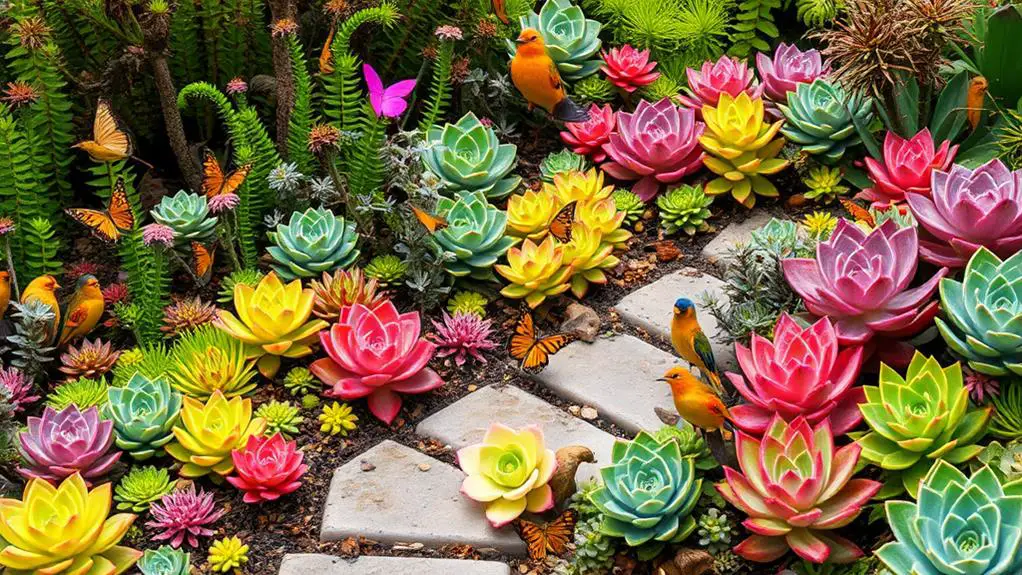
When selecting the right succulents for your small garden, focus on varieties that produce vibrant flowers to attract pollinators like butterflies and hummingbirds. Start with options like Echeveria and Sedum, which bloom beautifully during their seasons. These colorful flowers will naturally draw in those fluttering visitors.
Incorporating native plants is essential. Native succulents are well-adapted to your local environment and can better support local wildlife. This increases the chances of attracting butterflies and hummingbirds.
Look for a mix of colors and textures to make your garden more appealing. For example, pair red or orange flowers with blue or green foliage. This contrast not only looks stunning but also makes the garden more inviting.
Make sure your succulents thrive by placing them in areas that receive full sun. Most succulents love sunlight, which encourages them to flower more, enhancing the garden's attractiveness to pollinators.
Additionally, consider low-growing varieties or those that form clusters. These can provide shelter and resting spots for visiting wildlife, making your garden even more hospitable.
Adding Nectar-Rich Plants
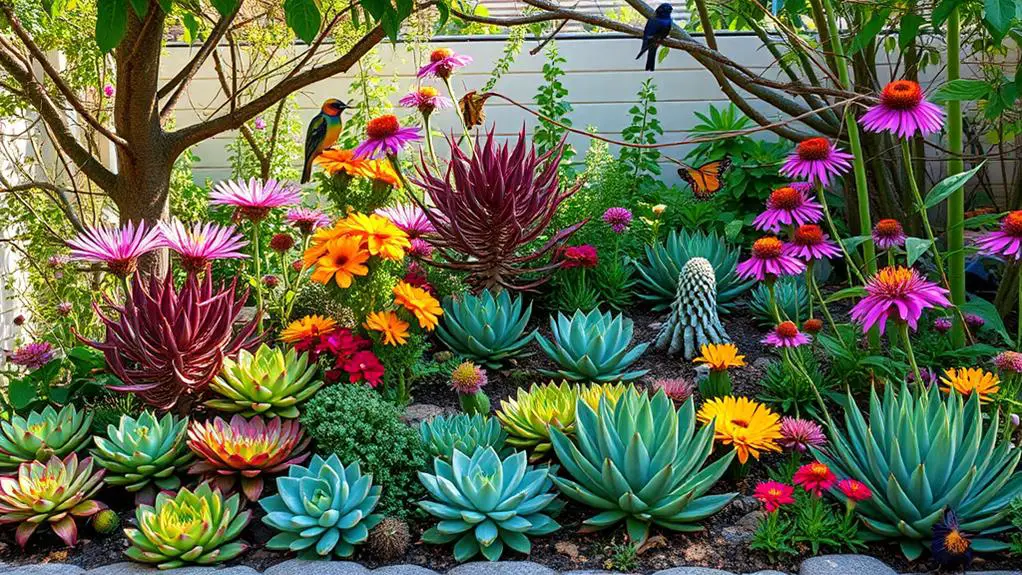
To make your succulent garden even more vibrant and wildlife-friendly, add some nectar-rich plants like bee balm, lantana, and butterfly bush.
These will attract butterflies and hummingbirds while providing essential food sources.
Choose native species and plan for different bloom times to keep your garden buzzing with activity all season long.
Nectar Source Variety
Adding a variety of nectar-rich plants to your small succulent garden can transform it into a vibrant, pollinator-friendly oasis. By incorporating flowering plants like bee balm and lantana, you'll provide essential food sources that attract birds and butterflies. These nectar-rich plants offer the sustenance that pollinators need, making your garden a lively spot for wildlife.
To create a successful garden, focus on including diverse flowering plants that bloom at different times. This guarantees a continuous supply of nectar from early spring to late fall. Native species like milkweed and purple coneflower are excellent choices. They're more likely to attract local butterfly populations and support their life cycles.
Also, think about the visual appeal. Mix vibrant nectar-rich plants with your succulents to create striking contrasts. This not only enhances the garden's beauty but also makes it easier for butterflies and hummingbirds to find food.
Creating clusters of nectar-rich plants will draw in pollinators, as they're attracted to larger patches of color and fragrance.
Seasonal Bloom Planning
Planning for seasonal blooms in your succulent garden guarantees a vibrant and continuous display of color that attracts pollinators year-round. To achieve this, incorporate a variety of nectar-rich plants like bee balm, butterfly bush, and lantana. These plants provide essential food sources for butterflies and hummingbirds throughout the growing season.
When you're doing your seasonal bloom planning, select plants that bloom at different times of the year. This assures your garden has flowers from early spring to late fall. By doing so, you'll attract a diverse range of pollinators and keep your garden lively with butterflies fluttering and hummingbirds visiting.
Consider adding native flowering plants such as milkweed and Joe Pye weed. These not only thrive in local conditions but also support local butterfly populations, providing essential nourishment for caterpillars.
Position taller nectar-rich plants near your succulent arrangements to create visual layers. This makes your garden more inviting for birds and butterflies while keeping it aesthetically pleasing.
Use a mix of annuals and perennials to guarantee a vibrant display of color and continuous nectar availability. Pay particular attention to species known to attract specific butterfly varieties prevalent in your area.
This thoughtful planning will make your garden a haven for pollinators.
Native Plant Benefits**
Incorporating native nectar-rich plants into your succulent garden isn't just about aesthetics; it's an essential step towards promoting biodiversity and ecosystem health. By adding these plants, you're ensuring that local bird and butterfly species have access to vital food sources.
Native plants are perfectly adapted to your local climate and soil conditions, meaning they need less water and maintenance compared to non-native species. This makes them perfect for sustainable gardening.
To keep butterflies and hummingbirds visiting your garden, include a variety of native flowering plants that bloom at different times throughout the season. This way, there's always something for them to feed on.
Plants like milkweed and bee balm are fantastic choices. Not only do they attract pollinators with their nectar, but they also serve as host plants for caterpillars, supporting the entire lifecycle of butterflies.
By selecting native plants, you create a habitat that's more resilient to pests and diseases. This means a healthier environment for both your plants and the wildlife that visits.
- Less Maintenance: Native plants need less water and care.
- Continuous Bloom: Different bloom times provide year-round nectar.
- Support Lifecycles: Host plants like milkweed support caterpillars.
Adding native nectar-rich plants is a simple yet powerful way to support your local ecosystem.
Designing With Contrasting Colors
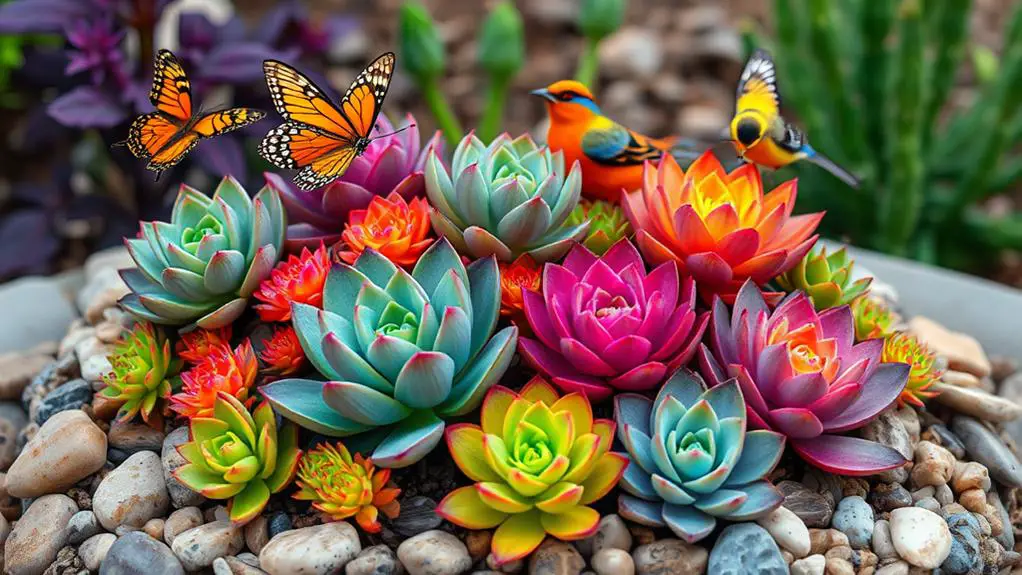
Creating a visually striking succulent garden hinges on the effective use of contrasting colors. By combining vibrant reds and oranges with cool blues and greens, you can create an enchanting display that attracts both birds and butterflies.
Balance is key; pair warm-hued succulents like Echeveria with the blue-green tones of Agave or Aloe varieties to enhance visual interest.
It's important to reflect on the seasonal color changes of your succulents. Some varieties will take on rich hues in colder months, ensuring your garden remains appealing all year round.
In addition to color, think about texture. Place smooth-leaved succulents next to spiky cacti to create a dynamic landscape. This contrast not only adds visual intrigue but also provides shelter and nectar for pollinators.
Strategically placing colorful flowering plants, like milkweed or lantana, among your succulents can further enhance your garden's appeal. These plants offer additional nectar sources, making your garden even more attractive to butterflies and birds.
Incorporating Water Sources
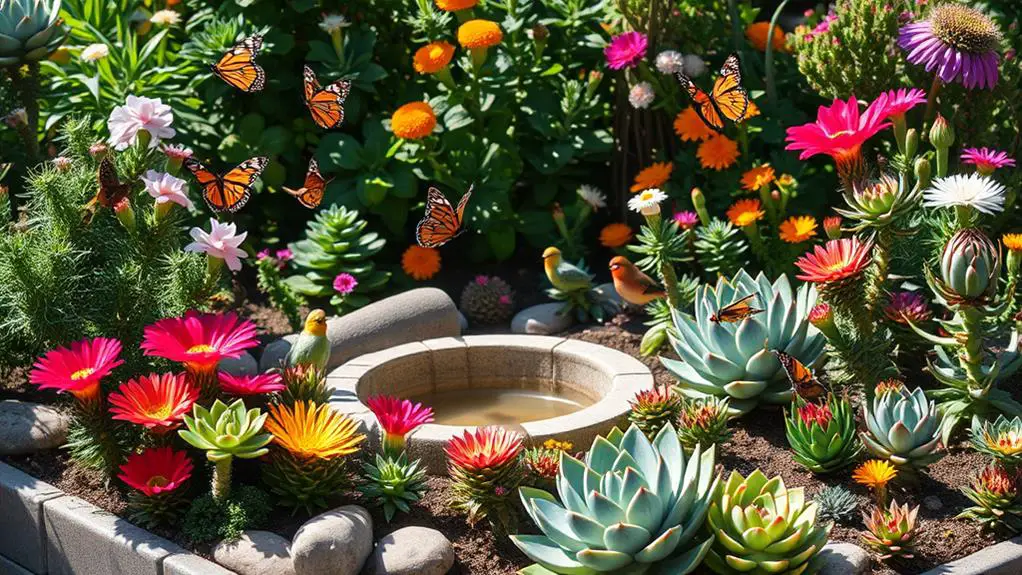
Enhance your succulent garden by adding water sources that attract and sustain local wildlife. Installing shallow bird baths or small ponds with a depth of no more than three inches provides essential hydration for birds and butterflies. These water sources can considerably boost the garden's appeal and functionality.
Incorporate rocks or pebbles in your bird baths to create safe perching spots for butterflies, allowing them to access water while basking in the sun. This not only helps them stay hydrated but also encourages them to linger in your garden, contributing to pollination.
Regularly refresh the water in your bird baths to prevent stagnation. Stagnant water can deter wildlife and promote algae growth, which isn't healthy for your plants or your garden visitors. Clean, fresh water is more likely to attract a variety of pollinators.
Additionally, consider using a small fountain or gentle water spray. The sound of moving water can attract hummingbirds, making your garden even more lively and vibrant.
- Use shallow bird baths or small ponds (max 3 inches deep).
- Add rocks or pebbles for butterfly perching spots.
- Regularly refresh water to prevent stagnation.
Creating Shelter and Perches
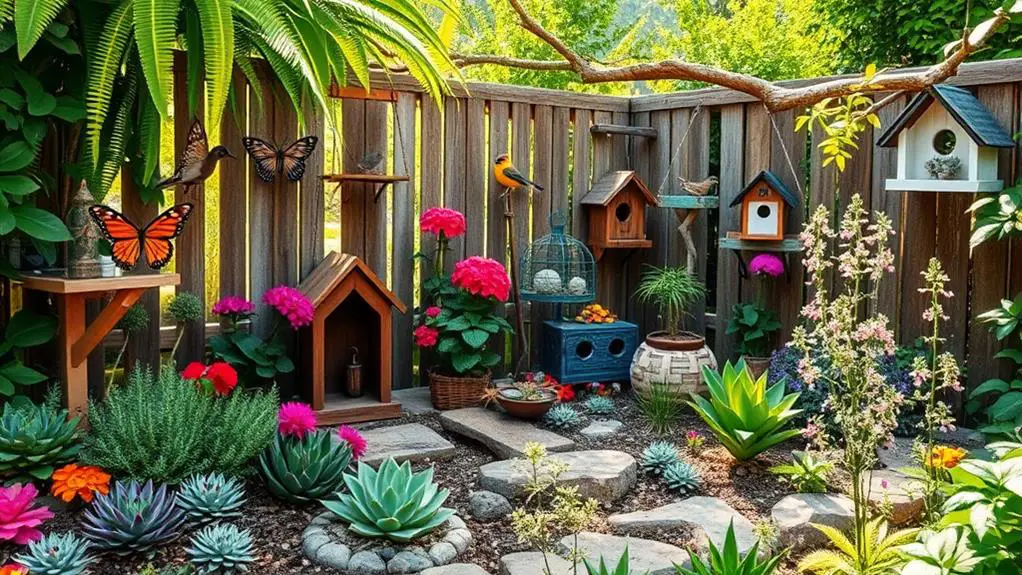
While water sources enhance the appeal of your succulent garden, equally important is providing shelter and perches to make it a haven for local wildlife.
Start by incorporating a variety of native shrubs and small trees. These plants offer nesting sites and protect birds from predators, making your garden more inviting.
Don't forget to add taller succulents or ornamental grasses. They act as windbreaks, giving smaller birds a safe place to hide.
For perches, use decorative elements like driftwood or rocks. Birds and butterflies will appreciate having a spot to rest and survey their surroundings.
You can also install birdhouses or butterfly houses. These structures provide safe refuges and encourage these creatures to stay longer in your garden.
Sunny spots with flat rocks are perfect for butterflies. They love to bask in the sun to regulate their body temperature.
Make sure your garden includes these warm surfaces. It doesn't have to be complicated—just a few well-placed rocks can make a big difference.
Using Organic Gardening Practices
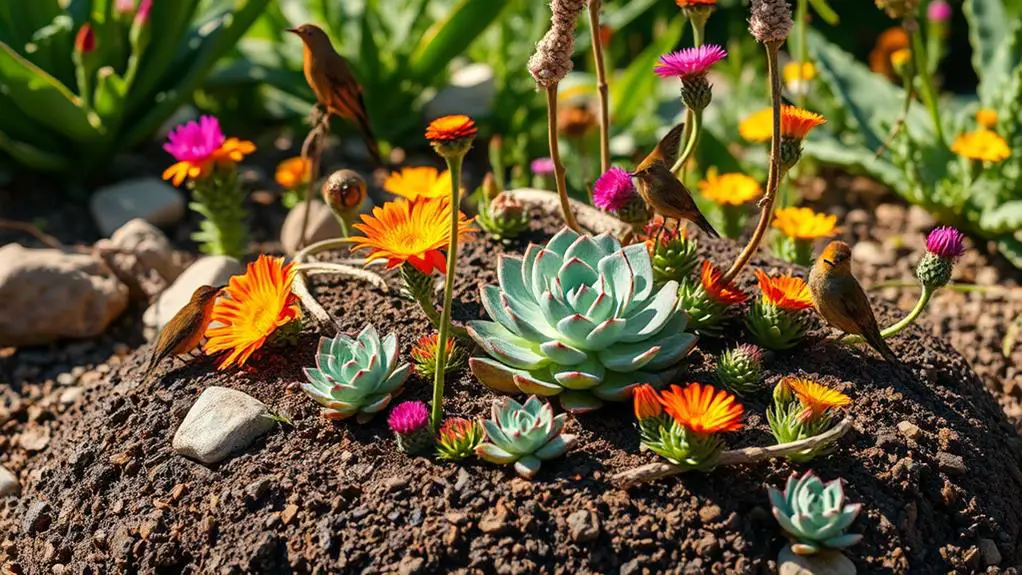
When creating your succulent garden, using organic gardening practices helps your plants thrive and supports local wildlife.
Start with compost or worm castings to nourish your succulents naturally, and introduce ladybugs for natural pest control.
Adding organic mulch like shredded leaves or straw will retain moisture and provide a home for beneficial insects.
Natural Pest Control
Implementing organic gardening practices in your small succulent garden can effectively control pests without harming beneficial insects like butterflies and bees.
Start by introducing natural predators like ladybugs and lacewings. These beneficial insects help keep pest populations in check, creating a balanced ecosystem in your garden. You can buy them online or at garden centers and release them onto your plants.
Another effective method is using neem oil or insecticidal soap. These organic gardening practices target harmful pests while sparing the good bugs. Simply spray the solution on affected plants, and you'll see a significant reduction in pest activity without harming the insects you want to keep.
Consider companion planting with herbs like basil and mint. These herbs repel common pests and attract pollinators, which enhances the biodiversity of your garden. Plus, they add a lovely fragrance and can be used in your cooking!
- Introduce natural predators: Ladybugs and lacewings keep pest populations down.
- Use neem oil or insecticidal soap: Target pests without harming beneficial insects.
- Companion planting with herbs: Repel pests and attract pollinators.
Compost and Mulching**
How can you make your succulent garden thrive naturally? One key method is by incorporating compost into your garden. Compost enriches the soil with essential nutrients, promoting healthy plant growth. This attracts birds and butterflies looking for food sources.
By composting kitchen scraps and garden waste, you reduce landfill waste and create a sustainable source of organic matter.
Another important practice is using organic mulch, like shredded leaves or bark. Organic mulch helps retain soil moisture, reduce weed growth, and maintain stable soil temperatures. This creates a comfortable environment for your succulents and the beneficial insects that support your garden's ecosystem.
Regularly applying a layer of mulch also provides a habitat for these insects, which can help control pest populations naturally.
Avoiding chemical fertilizers and mulches is significant. By doing so, you create a safer environment for birds and butterflies, ensuring your garden supports their needs without harmful substances.
Embracing these organic gardening practices not only helps your succulent garden flourish but also contributes to a thriving ecosystem, making your garden a welcoming haven for wildlife.
Maximizing Small Spaces
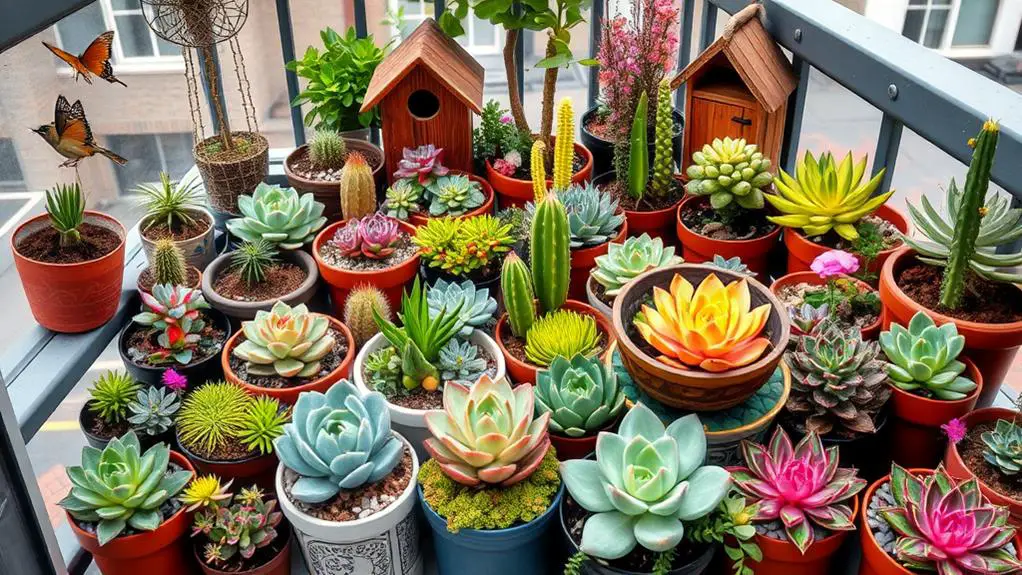
Transforming a compact area into a thriving succulent garden can be a rewarding challenge, especially when you make the most of your available space.
Here are some tips to help you maximize your small garden and create an inviting butterfly garden for plants and pollinators.
Start by utilizing vertical gardening techniques. Hanging planters or wall-mounted shelves not only save space but also provide additional surfaces for pollinators to land on.
Choose compact succulent varieties, like Echeveria or Haworthia, which thrive in small containers or grouped arrangements. These plants are perfect for tight spaces and still offer plenty of visual interest.
Incorporate layered plantings in your garden. Place taller succulents at the back and shorter ones in the front. This creates a visually appealing display and makes your garden more accessible to birds and butterflies.
Don't forget to add decorative elements such as birdbaths or shallow water dishes. These features attract wildlife and fit harmoniously within your limited space.
- Utilize vertical gardening techniques
- Choose compact succulent varieties
- Incorporate layered plantings
Frequently Asked Questions
What Succulents Attract Birds?
Crassula plants, especially Crassula ovata (Jade Plant), attract small birds when they bloom. Birds are drawn to the clusters of tiny flowers these succulents produce, making them a great addition to your garden.
How to Create a Butterfly Bird Garden?
You can create a butterfly and bird garden by planting nectar-rich flowers like milkweed and bee balm, adding shallow water features, mixing plant heights, using native plants, and ensuring the garden gets at least six hours of sunlight daily.
How Do I Start a Small Butterfly Garden?
Start your butterfly garden by planning a layout with nectar-rich flowers and host plants. Make certain it gets 6 hours of sunlight daily. Add shallow water sources and create shelter areas to protect butterflies from predators and weather.
How Do You Create a Butterfly Habitat?
To create a butterfly habitat, plant nectar-rich flowers that bloom at different times, include larval host plants, guarantee 6 hours of sunlight daily, add shallow water sources, and avoid pesticides. This setup supports butterflies through their lifecycle.
Conclusion
You've got all the tips you need to create a beautiful succulent garden that birds and butterflies will love. Remember to choose vibrant succulents, add nectar-rich plants, and design with contrasting colors. Don't forget the water sources, shelter, and perches. Stick to organic gardening practices and make the most of your space. With these steps, your garden will be a thriving, colorful oasis for both you and the pollinators to enjoy. Happy gardening!

